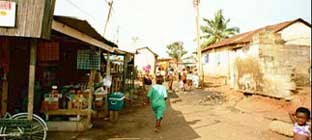|
Context Summary
Ghana is approximately 238,500 square kilometers and the population is approximately 18 million with an overall population density of 75 persons per square kilometer. Ghana is a lowland country except for a range of hills on its eastern border. The Akosombo Dam on the Volta River forms one of the largest lakes in the world and generates much of Ghana’s electricity. The economy is largely based on agriculture, and Ghana was once the world’s largest producer of cacao. Mining, logging, fishing and light industry are also key industries. The Gross National Product per capita is about US$400.
Following independence from Britain in 1957, the economy of Ghana weakened. With the adoption of more market-oriented policies and support of the international community, Ghana’s economy and infrastructure have, in recent years, begun to improve.
In 1997, about 6.7 million people, an estimated 37 percent of the total population, lived in urban areas. It is estimated that some 1.9 million urban residents live below the poverty line. Accra, the capital city, has a population of approximately 2.2 million and accounts for about 25 percent of the urban population. Accra and Kumasi together contain over 40 percent of the total urban population.
The Greater Accra Metropolitan Area (GAMA) includes the cities of Accra and Tema (Ghana’s port town east of Accra) and accounts for approximately 20 percent of GDP and employs about 10 percent of the national work force (one-third of the national urban work force). Tema is Ghana’s primary port, handling about 75 of all goods shipments.
Typical problems in the urban areas include:
- Existing low-income communities continue to expand and densify due to complex land ownership and land allocation process.
- The Local Government system is in a state of flux with decentralization and there is insufficient focus by Local Assemblies on the upgrading of poor areas.
- There is some experience of upgrading but still few systems, policies, procedures and recognition of “affordability-based” planning and guidelines on cost recovery, etc.
- Parts of the communities are inaccessible by vehicle due to the poor state of primary, secondary and tertiary access roads.
- Water supply systems are generally available in low-income communities but only about half of the properties have individual connections.
- Sanitation and drainage are both generally very poor and there is widespread use of communal toilet facilities and use of bucket latrines
- There is little maintenance culture.
Lessons from Recent Projects - Summary
Impact
The upgrading schemes have resulted in a dramatic improvement in environmental and sanitation conditions in the communities. The recognized success of the programs could set the stage for a national upgrading program.
- Improved solid waste collection has reduced the accumulation of garbage in areas where children play, and parents cook and clean their dishes and utensils.
- Improved drainage has lead to reduced flooding in most areas, slowing the spread of waterborne diseases. Significant health benefits are thought to have accrued.
- Paved streets and improved access to communities have resulted in a proliferation of small businesses and kiosks in areas that previously used to be repositories of trash and human waste.
- Upgrading has motivated individual households to invest more in improving their shelter structures, and to do more to maintain their improved environments.
- The introduction of street lighting in some areas has reduced the incidence of crime.
- In all the upgraded areas, communities appear more buoyant and economic activity has been stimulated.
- The benefits of upgrading extend beyond the specific areas upgraded. For example, people from the areas around Maamobi use the communal toilets, waste containers and running water facilities in the upgraded areas.
- The impact of the upgrading schemes in Ghana has been such that they have fostered political support, with residents not only praising these schemes to local politicians but also asking why more could not be done. The government, in turn, has recognized that the upgrading approach is a vital way to addressing the many problems of Ghana’s poor urban communities in a cost effective manner within a reasonable timeframe.
Lessons Learned
- Advanced planning in the design of infrastructure to ensure easy add-on of expanded services is critical. A first wave approach of providing minimum basic infrastructure will allow the program to quickly reach large numbers of the population. With incremental follow-up, other infrastructure and social services, such as health and education facilities, and income generation activities, can be built on this foundation.
- The lowest cost options should be actively sought to allow greater coverage with limited resources.
- Large scale programs cannot be carried out without the active involvement and fiscal commitment of local authorities.
- Enhanced cost recovery efforts should include a plan to address land security/ownership to allow the government to recoup at least part of the cost of upgrading. Property valuation rolls should be kept up to date and the efficiency of property tax collection improved, possibly with the use of the private sector. Betterment taxes could also be considered, but within a context of equity and ability-to-pay of residents.
- Realistic programs for improving citywide operation and maintenance by local governments need to be developed. Ad-hoc maintenance programs, driven and funded by the communities themselves, cannot support a scaled-up program in full.
- Planning for the expansion of the primary networks in conjunction with the upgrading of smaller communities will be critical to ensuring a functioning infrastructure delivery system. A large-scale upgrading program will invariably put great pressures on a city’s primary infrastructure and services networks.
- Any large-scale program should establish a robust mechanism for monitoring progress and measuring the impact of its interventions.
|


